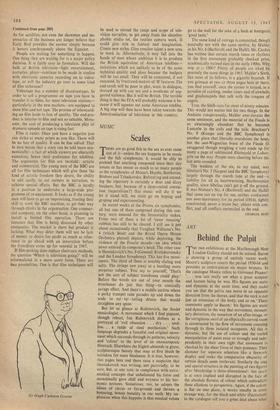M U S I C
Scales
rTHERE are as good fish in the sea as ever came 1 out of it—unless the sea happens to be music and the fish symphonies. It would be silly to pretend that anything composed since their day means or has meant as much to so many people as the symphonies of Mozart, Haydn, Beethoven, Brahms and Tchaikovsky. Refreshing and extend- ing the repertory is certainly a dear and dicey business, but, because of a deep-rooted convic- tion (superstition?) that music will die if we let it stand still, we must go on hoping and groping and experimenting.
In recent weeks at the Proms six symphonies, all but one of them composed' during this cen- tury, were entered for the Immortality stakes. From two of them a lot of 'inner meaning' rubbish has still to be cleared. I still see it put about occasionally that Vaughan Williams's No. 4 (which Boult and the Royal Opera House Orchestra played) depicts, while deploring, the violence of the Fascist decade—an idea which never entered its composer's head. The other case is Shostakovich's No. 8 (Gennadi Rozhdestvensky and the London Symphony). This has five move- ments. The third of them is notably elating and salty. The strings saw away at a bustling moto perpetuo subject. You say to yourself, 'That's not the sort of subject trombones could play.' Before the words are out of your mouth the trombones do just that thing—to comically savage effect. And there's a middle section where a perky trumpet tune parades up and down the scale to rat - tat - tatting drums that would straighten any spine.
But let us glance at Rabinovich, the Soviet musicologist. A movement which I find piquant, though robust, fun Rabinovich defines as a portrayal of 'evil obsession . . . dry . . . soul- less. . . a rattle of steel mechanism.' Such language degrades a forceful and original move- ment which succeeds through its patterns, velocity and 'colour' to the level of an onomatopoeic filmtrack. Elsewhere the Eighth abounds in grave, sculpturesque beauty that may at first blush be mistaken for mere bleakness. It is true, however, that pages here and there raise a suspicion that Shostakovich was writing, not pictorially, to be sure, but, at any rate, in compliance with extra- musical concepts that unbalanced his fotm and occasionally gave chill and wryness to his har- monic textures. Sometimes, too, he adopts the idiom of circus or fairground and throws a bouncing, brassy banality in our teeth. My im- pression ression when this happens is that musical values
go to the wall for the sake of a bash at bourgeois 'good taste.'
The same kind of outrage is committed, though assuredly not with the same motive, by Mahler in his No. 6 (Barbirolli and the Halle). Mr. Cardus has written that certain march tunes or rhythms in the first movement probably shocked prim, academically trained ears in the early 1900s. Why stop at c. 1906? Plenty of people are irked hy precisely the same things in 1965. Mahler's Sixth, like most of its fellows, is a gigantic brantub. If you grimace at two cr three pages here or there, you find yourself, once the corner is turned, in a paradise of cajoling, tender tunes and of cowbells and glockenspiels that talk with the tongues of angels.
True, the Sixth runs for most of ninety minutes. This would not matter but for two things. In the Andante conspicuously, Mahler over-iterates the same sentiment, and the material of the Finale is so swarmingly abundant that he becomes Laocoon in the coils and the toils. Bruckner's No. 8 (Kempe and the BBC Symphony) is, another piece that liberally overshoots the hour, but the neo-Wagnerian brass of the Finale (it swaggered though weighing a ton) made up for many a page of sublimated Rheingold or Lohen- grin on the way. People were cheering before the last note sounded.
The weakest of the six, to my mind, was Sibelius's No. 3 (Sargent and the BBC Symphony) largely through the march tune at the end---a liability for all its heartwarming, Beethovenian quality, since Sibelius can't get it off the ground,. It was Nielsen's No. 4 (Barbirolli and the Halle) that came out on top for me; neither conformist nor over-innovatory for its period (1916), tightly constructed, never a waste bar, ablaze with con- flict, and all conflicts reconciled in the end.
CHARLES REID






























 Previous page
Previous page